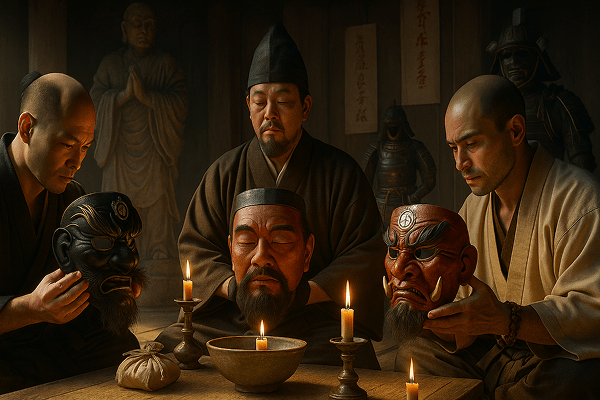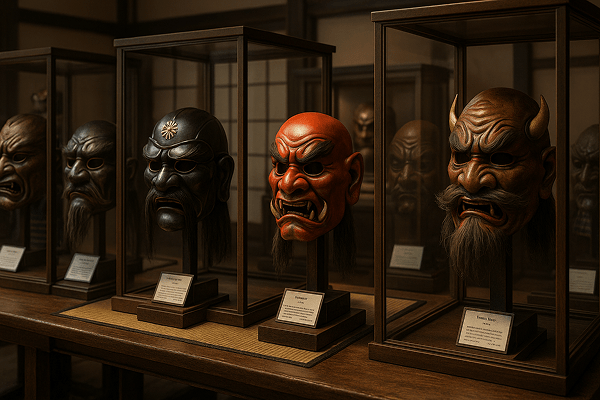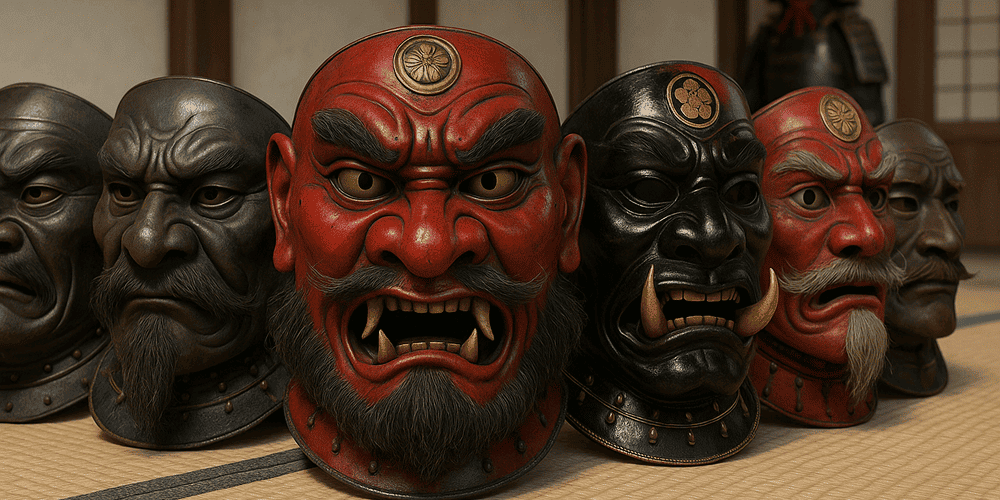Samurai masks, known as “menpō” (面頬), “mengu” (面具), or “men-yoroi” (面鎧) in Japanese, are an iconic element of Japan’s samurai armor and cultural history. Instantly recognizable for their fierce expressions, bold forms, and elaborate craftsmanship, samurai masks were designed to protect the warrior’s face in battle and to intimidate opponents. These masks often feature exaggerated facial features such as scowling mouths, sharp fangs, mustaches, and fierce brows, sometimes adorned with detachable noses (hanabushi) or elaborate facial hair made of horsehair. Samurai masks belong to the martial culture of feudal Japan, particularly from the Kamakura period (1185–1333) through the Edo period (1603–1868), and are closely associated with the legendary samurai class.
Historical Origins of Samurai Masks
The history of samurai masks can be traced back to ancient Japan, when early forms of facial armor were introduced to provide additional protection and psychological advantage in battle. The term “menpō” literally means “face protection,” while “mengu” refers more broadly to facial armor. The development of samurai masks accelerated during the Kamakura and Muromachi periods, as warfare became more organized and armor technology advanced. Historical records and surviving artifacts indicate that early masks were simple, covering only the cheeks or chin, but grew more elaborate in the Sengoku period (1467–1600), when full-face menpō and half-face hanbō became popular. Over time, the design of samurai masks evolved to balance protection, comfort, and the projection of fearsome or heroic identities.
Cultural Significance and Symbolism of Samurai Masks
Samurai masks hold deep symbolic meaning in Japanese culture, representing not only martial power but also spiritual beliefs and ancestral connections. The fierce expressions and animalistic features of many masks were intended to frighten enemies and invoke protective spirits in battle. Some masks were believed to embody the qualities of legendary warriors, demons, or guardian deities, blurring the line between human and supernatural. Ritual purification and offerings often accompanied the crafting and wearing of masks, emphasizing their sacred status. Myths and legends tell of samurai whose masks granted them supernatural courage or protection, while others became famous for their distinctive facial armor. In the social context, samurai masks served as status symbols, signaling rank, clan affiliation, and personal valor. They also reinforced ideals of bushidō (the way of the warrior), such as loyalty, honor, and self-discipline.

Materials and Craft Techniques of Samurai Masks
Traditional samurai masks were typically made from iron, steel, leather, or a combination of these materials, sometimes covered in lacquer to prevent rust and enhance durability. Artisans used specialized forging and hammering techniques to shape the metal, followed by intricate engraving, painting, and lacquering. High-quality masks often featured applied facial hair made from horsehair or yak hair, and interior padding for comfort. Decorative elements included gold or silver inlays, clan crests, and colored pigments to highlight features. Regional differences in mask-making are evident: masks from the Kaga and Edo regions are renowned for their meticulous construction and ornate detailing, while others prioritized functionality and protection. Color symbolism played a role as well — red might signify courage, black strength, and gold divine favor. The process of making a samurai mask required collaboration between armorers (kacchū-shi), painters, and leather workers, with each mask reflecting the artisan’s skill and the wearer’s identity.
Functions and Uses of Samurai Masks
The primary function of samurai masks was martial: they shielded the face from weapons, arrows, and debris, while also concealing the identity and emotions of the warrior. The intimidating appearance of the mask could unsettle opponents and boost the morale of allied troops. Samurai masks were also worn during ceremonial processions, military reviews, and rituals honoring ancestors or deities. On occasion, masks appeared in theatrical performances, particularly in Noh theater, where themes of heroism and transformation paralleled the samurai ethos. Over time, as warfare declined in the peaceful Edo period, samurai masks became more symbolic and decorative, used for parade armor, displays, and as collector’s items. In modern times, samurai masks are featured in festivals, museum exhibitions, martial arts demonstrations, and even contemporary fashion and art, demonstrating their continued cultural relevance.
Regional Variations of Samurai Masks
Different regions of Japan developed distinct styles and traditions in samurai mask design. The Kaga province, for example, became famous for its finely wrought iron menpō with delicate lacquer work and detailed facial hair. Edo-period masks from the capital were often more ornate, reflecting the wealth and status of their owners. In contrast, rural and provincial armorers tended to produce simpler, more utilitarian masks. Variations also existed in mask shape — some covered only the lower face (hanbō), while others protected the entire face (sōmen). Local artistic influences, such as Noh theater and Shinto iconography, contributed to regional diversity. Compared to similar mask traditions in China or Korea, Japanese samurai masks are unique in their combination of martial utility, psychological impact, and aesthetic refinement.
Famous Examples and Collections of Samurai Masks
Some of the most significant samurai masks are preserved in museums and private collections in Japan and around the world. The Tokyo National Museum and the Kyoto National Museum house exquisite examples of menpō from the Kamakura, Muromachi, and Edo periods, including masks once owned by famous warlords. The Samurai Armor Museum (Tokyo), the Ann and Gabriel Barbier-Mueller Museum (Dallas), and the Met (New York) feature renowned collections of Japanese armor and masks. Important historical finds include masks recovered from castle sites, temple treasuries, and battlefield excavations. Private collectors and international exhibitions, as well as digital galleries such as toddmasks.com, offer further opportunities to study and appreciate these masterpieces. Some masks are legendary for their association with famous battles or their remarkable artistry.

Influence of Samurai Masks on Art and Culture
The influence of samurai masks on Japanese and global art is profound. Their dramatic forms and expressive features have inspired painters, sculptors, filmmakers, and fashion designers both in Japan and internationally. In literature and cinema, the image of the masked samurai evokes themes of mystery, power, and transformation. Samurai masks have appeared in countless films, anime, and graphic novels, reinforcing their iconic status. Their motifs are frequently adapted in contemporary jewelry, tattoo art, and stage design, blending tradition with modern aesthetics. The preservation and reinterpretation of samurai mask culture play a key role in the ongoing celebration of Japanese heritage, ensuring that the values and artistry of the samurai endure in the public imagination.
Contemporary Status and Preservation of Samurai Mask Traditions
Today, the tradition of samurai mask making is preserved by master craftsmen, museums, and cultural organizations. Artisans continue to produce high-quality replica masks using traditional techniques, serving collectors, martial artists, and enthusiasts. Educational programs, workshops, and museum exhibitions — often featured on toddmasks.com — help transmit the history and craft of samurai masks to new generations. Innovations in materials and digital technology enable the creation of modern interpretations, while academic research and restoration projects safeguard historic examples. Festivals, martial arts schools, and reenactment groups also contribute to keeping the tradition alive, adapting it for contemporary audiences. The enduring appeal of samurai masks lies in their blend of artistry, symbolism, and historical resonance.
Collecting and Acquiring Samurai Masks
The market for samurai masks is robust, with authentic antique examples highly sought after by collectors worldwide. Genuine samurai masks can be found in reputable galleries, auction houses, and directly from artisans who specialize in traditional armor. Prices vary widely, depending on age, craftsmanship, provenance, and historical significance — some rare masks command prices in the tens of thousands of dollars. Collectors should always seek expert authentication, verify provenance, and prioritize ethical acquisition, respecting cultural heritage and supporting artisan communities. High-quality replicas and contemporary masks are also valued for their artistry and educational use. Toddmasks.com offers guidance on collecting, authentication, and the ethical dimensions of acquiring samurai masks, ensuring responsible and informed collecting practices.
